The Recessive Image
Hantian Xue
“The digital image", Sally Mann
once suggested in an interview, "is like vapour that never comes to
ground. It simply circulates, bodiless. It has no material reality".
From the very beginning of photography, the instinctive hostility of humans to this medium has been revealed quite directly: photographs, whether those that have attempted to show the quality of craftsmanship or those that seek to imitate reality in pixels, are difficult to trust. This seems to have formed a consensus that transcends the ages. But the relationship between people and photographs is by no means limited to this; under the right conditions, we still choose to take the presence of photographs or images as a criterion for determining tangible traces in the real world, while readily ignoring their potential pitfalls. In fact, it seems that a period of history with image records always has more privilege of being “remembered” than that without visual materials.
In the era of digital photography, the boundary between "photograph" and "image" has become more blurred. I attempt to observe this point from the research in the field of criminal investigation in recent years and find it very interesting. Among the eight types of evidence in the Criminal Procedure Law of China, the most decisive are physical evidence, documentary evidence and testimony of witnesses. They record either static facts or dynamic facts: permanent facts can only exist in objects and thus constitute physical evidence; transitory facts recorded by images are documentary evidence, while transitory facts perceived by people are testimony of witnesses.
In a general sense, images fall under the category of documentary evidence. In most cases, they are physical and are considered capable of objectively recording reality. However, with technological advances and inevitably diverse media materials, controversial evidence categories such as “audiovisual materials” have gradually arisen. These include audio and video produced by physical processes, electronic computer records, as well as “high-tech images” generated during case handling—so-called simulated images obtained with the help of laser, infrared, x-ray and other sophisticated instruments. On reflection, it seems that the "simulated images" mentioned are not "simulations" per se. (Aren't CT images of real bodies?) What they record is certainly a reality, one that we cannot penetrate with our eyes. Similarly, if shooting devices using laser and x-ray are considered sophisticated instruments, then cameras also have the same “high-tech” attributes to a certain extent.
Peruse papers in the field of criminal investigation in recent years, and one will find more similar sampling attempts presented with the help of new scientific techniques. One of the techniques mentioned in several papers is image stitching for the two-dimensional high-resolution acquisition of curved evidence surfaces. In this way, not only photographs and images, but also the relationship and the boundary between objects and images will change. Should this set of collected flat images finally be adopted as documentary evidence, physical evidence or audiovisual materials?
![]() The Killing of Harith Augustus-Milliseconds, Still from Forensic Architecture, 2020
The Killing of Harith Augustus-Milliseconds, Still from Forensic Architecture, 2020
The reason for using criminal investigation evidence as an entry point for exploration is simple—it cannot retain sufficient latitude for the content and form presented by materials as contemporary art theory does, and its judgment of whether the evidence is credible leads instantly to a specific result. However, this procedure, which relies on the operation of reason, does not always deliver the right verdict. We often feel that its understanding of images is rather limited, or that there is a sense of ambiguity, just like the historical tangle that has always remained unsettled between us and photography. As much as we want to use photography for recording and proving the truth, we dread what it may conceal from us. Perhaps the essence of photography is indeed as Sally Mann and Roland Barthes have said: it is a presence close to a ghost, transparent, elusive, invisible, and indefinable.
This is also the personal understanding of images that I have gradually uncovered from Wu Yumo's work since she began working on "The Transparency Photograph" series in 2019. I think there is a reason for not using the adjective "transparent" here but the noun form - instead of "transparent" photography, photography itself is transparency. The concept of “transparency” we mention here is fundamentally different from Kendall Walton's idea that photography is a “supremely realistic medium”, or we can say it is actually closer to the “emanations” mentioned by Roland Bathes in Camera Lucida. It is retreating indefinitely from distinct physical forms and ideologies, yet it always bothers those who attempt to see it. Precisely because it brings us a civilized code of perfect illusions, photography is endowed with the quality of "other" in the psychoanalytic sense, which is created to mend and heal the eternal wound of desire.
![]() Yumo Wu, Trembling Residual Pixels, from the series The Transparency Photography, 2020
Yumo Wu, Trembling Residual Pixels, from the series The Transparency Photography, 2020
In "The Transparency Photography" series, the figurative meaning of photographs is set aside, but the prominent properties of digital materials as "images" magnify their production process and reveal the unique features of digital cameras as a medium. At a time when silver salts were used in photography, we witnessed a revolutionary exploration for the properties of this medium by photographers to counter the irreproducibility of the painting medium. Fast-forward to today's digital photography era, as Susan Stewart put it, artists are becoming nostalgic for the uniqueness and craftsmanship of photographic films. (Just look at how many people favor the “film style" function in photo editing software these days.) They come to resist the uniformity of pixel images and the amazing ease of operation... In short, this shows an underlying fear of the democratization and popularization of photography.
In these two series, Wu Yumo follows this kind of operation to amplify the electromagnetic texture of digital photography. High-fidelity and high-resolution images turn out to be “wrong images” here — as photographs, they are “failures” because they could not clearly convey the kind of immediacy and credibility that can imitate reality, but they point directly to another process pattern of contemporary photography through deliberate confusion. In particular, when it comes to the texture of electronic materials, I find that they do not feature the common "mistake" of cheap bluntness but are instead surprisingly detailed and precise. The images processed by computers are made transparent by manual interception. They are supposed to appear as a whole but are disassembled and alienated by this disruption and turned into layers that are difficult to interpret intuitively.
![]() Catherine Yass, Descent: HQ2: ?s, 20°, 0mm, 4mph, south, 2003
Catherine Yass, Descent: HQ2: ?s, 20°, 0mm, 4mph, south, 2003
Catherine Yass's 2002 series “Descend” explored a similar theme. Under the political haze of the 9/11 attacks, images she shot using distortions, reversals, long exposures and physical scratches inevitably had a tragic color: can we see a newly built skyscraper without imagining it falling into ruins? Likewise, when we see an electronic image online in the post-photographic era, can we view it as an independent object without purpose or indication (or did we ever have one)?
![]()
Gerhard Richter, Erschossener 1, 1988
On closer observation, many of Wu's works still retain visible traces of hand-painting, reminiscent of Jeff Walls' "Stumbling Block" and Gerhard Ritcher's "Erschossene". The former is a "digital montage" that combines several edited and directed "documentary photographs" via computer, while the latter is an oil painting in which the painter drew a newspaper photograph by hand. The mediums of these two works are completely different, yet they both manifest a rigorous resistance to images being seen as indexical symbols.
For Wu, this kind of “resistance” is also at the core of her creation. What she aims to show in her photographs is not any object but the photography as an object and the viewers who attempt to gaze at and interpret it. It seems that only when something breaks down and goes wrong does the real mechanism of its inner workings come to light. Jean Boudrillard considers photography to be a "perfect crime" precisely because it is merely a representation of what we want to see -- an empty symbol without context. If we seek to unravel this layer of meaning, we might only find that the nothingness it points to cannot stand up to scrutiny.
Sigmund Freud's theory has a unique understanding of "mistakes". He believed that the interpretation of dreams or subconscious is always fragmented. In these levels, psychoanalysts often interpret details rather than the whole. From the beginning, he viewed the human spiritual realm as a synthetic entity. This point may guide us to understand Wu’s attitude towards images in greater depth. As is shown in the part of images as criminal investigation evidence mentioned at the start of this article, even the most fact-oriented science can hardly avoid the trap of "entering the implied reality through illusions". In the history of photography, it seems that we are always challenged by various illusions. Whether it's the age of Talbot and Niepce or the era of Jeff Wall and Wolfgang Tillmans, it's breaking through our perceptions in dubious ways. The reality we seek from photography seems to be hidden in the darkroom, in the computer, or in the raw files that cannot be seen.
Wu has been acutely sensitive to the concept of “negative films” since the 2015 series “Dissolved Images”. For those who have studied film photography, touching a negative for the first time in the darkroom is indeed shocking. The experience almost has a religious ring to it, as a negative is often perceived as the pending form of a photograph that has not yet taken shape, rather than the photograph itself. This is probably a bit like seeing the embryo's heart beating through ultrasound. In his book Negative/Positive, Geoffrey Batchen delves into the subtle differences in status and the symbiosis between negative and positive films in the history of photography. He quoted Larry Schaff as saying, “From a physical-chemical point of view, there is no essential difference between a negative and a positive in Talbot’s work; the latter is merely a negative of a negative." In fact, not only for Talbot's work, but for all photographs, the positive and negative distinction is politically biased to some extent.
![]()
Yumo Wu, The Tanning Traces, from the series The Rupture of Vision, 2021
When seeing a negative, human eyes will repeatedly try to reverse it. For example, you can clearly feel this instinct with the first photo of Wu Yumo's "The Rupture of Vision" series. At first glance, we see a black powdery substance that rises up like a rocket with a breakthrough pattern, and it takes a brain filter to realize that it is a fountain of water rather than dust brought up by an explosion. But what makes this photograph astonishing is that, unlike other negatives, it is a negative that at first glance looks like a positive, as the boundary between the two is withdrawn in the brief processing of the brain.
In fact, if Freud were asked to interpret the relationship between positive and negative films, he would tend to think that the images presented by negative films are "real", while the infinite positive copies are the threat. Slavoj Žižek said that humans are the only animals that can deceive through truth, because there are times when we expect the truth to be taken as a lie so that we don't have to respond to its gaze. When we have to use reversal to confront and identify an image, we should be wary of this: what is the motive for this interpretation? I think this is the essential meaning of what negative films, and indeed any image that is considered "wrong", brings to us.
Is the so-called ethical threat posed by digital art truly as disruptive as imagined over the past half century? We are on the horns of a dilemma—this is the post-photographic era, but it seems that the plight of photography has never been completely overcome. Perhaps it is time to retreat one step in a different direction, and then another, to stand in the most primitive mistakes of the past to analyze and transcend the dizziness it brings to us at this moment.
From the very beginning of photography, the instinctive hostility of humans to this medium has been revealed quite directly: photographs, whether those that have attempted to show the quality of craftsmanship or those that seek to imitate reality in pixels, are difficult to trust. This seems to have formed a consensus that transcends the ages. But the relationship between people and photographs is by no means limited to this; under the right conditions, we still choose to take the presence of photographs or images as a criterion for determining tangible traces in the real world, while readily ignoring their potential pitfalls. In fact, it seems that a period of history with image records always has more privilege of being “remembered” than that without visual materials.
In the era of digital photography, the boundary between "photograph" and "image" has become more blurred. I attempt to observe this point from the research in the field of criminal investigation in recent years and find it very interesting. Among the eight types of evidence in the Criminal Procedure Law of China, the most decisive are physical evidence, documentary evidence and testimony of witnesses. They record either static facts or dynamic facts: permanent facts can only exist in objects and thus constitute physical evidence; transitory facts recorded by images are documentary evidence, while transitory facts perceived by people are testimony of witnesses.
In a general sense, images fall under the category of documentary evidence. In most cases, they are physical and are considered capable of objectively recording reality. However, with technological advances and inevitably diverse media materials, controversial evidence categories such as “audiovisual materials” have gradually arisen. These include audio and video produced by physical processes, electronic computer records, as well as “high-tech images” generated during case handling—so-called simulated images obtained with the help of laser, infrared, x-ray and other sophisticated instruments. On reflection, it seems that the "simulated images" mentioned are not "simulations" per se. (Aren't CT images of real bodies?) What they record is certainly a reality, one that we cannot penetrate with our eyes. Similarly, if shooting devices using laser and x-ray are considered sophisticated instruments, then cameras also have the same “high-tech” attributes to a certain extent.
Peruse papers in the field of criminal investigation in recent years, and one will find more similar sampling attempts presented with the help of new scientific techniques. One of the techniques mentioned in several papers is image stitching for the two-dimensional high-resolution acquisition of curved evidence surfaces. In this way, not only photographs and images, but also the relationship and the boundary between objects and images will change. Should this set of collected flat images finally be adopted as documentary evidence, physical evidence or audiovisual materials?
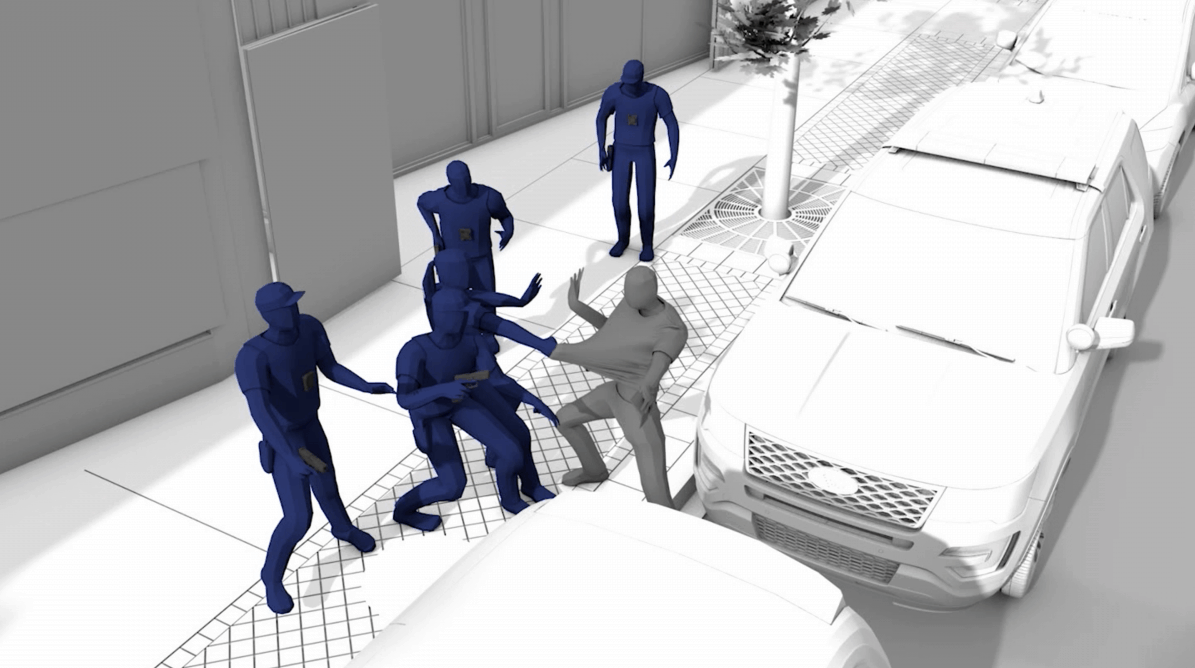 The Killing of Harith Augustus-Milliseconds, Still from Forensic Architecture, 2020
The Killing of Harith Augustus-Milliseconds, Still from Forensic Architecture, 2020The reason for using criminal investigation evidence as an entry point for exploration is simple—it cannot retain sufficient latitude for the content and form presented by materials as contemporary art theory does, and its judgment of whether the evidence is credible leads instantly to a specific result. However, this procedure, which relies on the operation of reason, does not always deliver the right verdict. We often feel that its understanding of images is rather limited, or that there is a sense of ambiguity, just like the historical tangle that has always remained unsettled between us and photography. As much as we want to use photography for recording and proving the truth, we dread what it may conceal from us. Perhaps the essence of photography is indeed as Sally Mann and Roland Barthes have said: it is a presence close to a ghost, transparent, elusive, invisible, and indefinable.
This is also the personal understanding of images that I have gradually uncovered from Wu Yumo's work since she began working on "The Transparency Photograph" series in 2019. I think there is a reason for not using the adjective "transparent" here but the noun form - instead of "transparent" photography, photography itself is transparency. The concept of “transparency” we mention here is fundamentally different from Kendall Walton's idea that photography is a “supremely realistic medium”, or we can say it is actually closer to the “emanations” mentioned by Roland Bathes in Camera Lucida. It is retreating indefinitely from distinct physical forms and ideologies, yet it always bothers those who attempt to see it. Precisely because it brings us a civilized code of perfect illusions, photography is endowed with the quality of "other" in the psychoanalytic sense, which is created to mend and heal the eternal wound of desire.
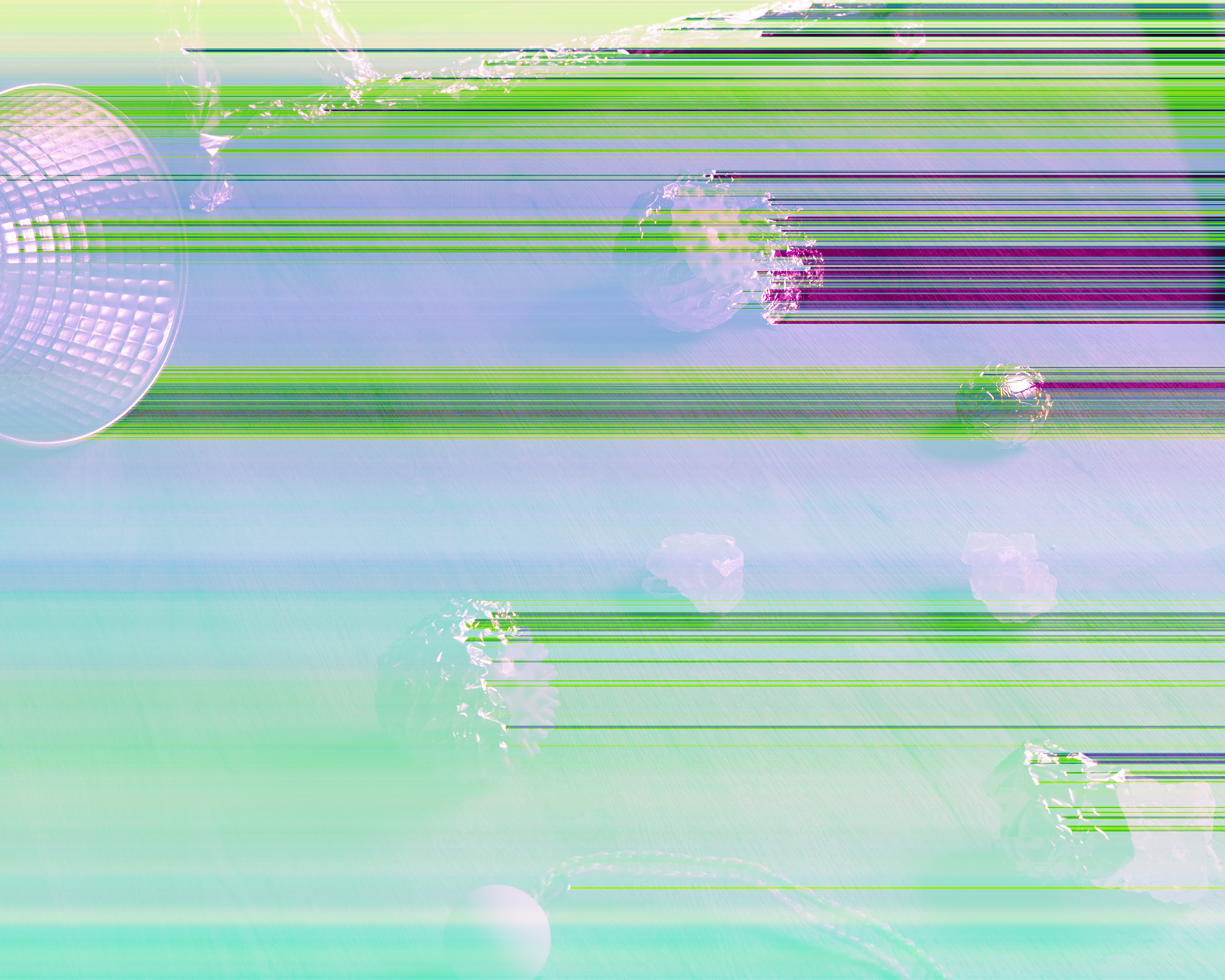 Yumo Wu, Trembling Residual Pixels, from the series The Transparency Photography, 2020
Yumo Wu, Trembling Residual Pixels, from the series The Transparency Photography, 2020In "The Transparency Photography" series, the figurative meaning of photographs is set aside, but the prominent properties of digital materials as "images" magnify their production process and reveal the unique features of digital cameras as a medium. At a time when silver salts were used in photography, we witnessed a revolutionary exploration for the properties of this medium by photographers to counter the irreproducibility of the painting medium. Fast-forward to today's digital photography era, as Susan Stewart put it, artists are becoming nostalgic for the uniqueness and craftsmanship of photographic films. (Just look at how many people favor the “film style" function in photo editing software these days.) They come to resist the uniformity of pixel images and the amazing ease of operation... In short, this shows an underlying fear of the democratization and popularization of photography.
In these two series, Wu Yumo follows this kind of operation to amplify the electromagnetic texture of digital photography. High-fidelity and high-resolution images turn out to be “wrong images” here — as photographs, they are “failures” because they could not clearly convey the kind of immediacy and credibility that can imitate reality, but they point directly to another process pattern of contemporary photography through deliberate confusion. In particular, when it comes to the texture of electronic materials, I find that they do not feature the common "mistake" of cheap bluntness but are instead surprisingly detailed and precise. The images processed by computers are made transparent by manual interception. They are supposed to appear as a whole but are disassembled and alienated by this disruption and turned into layers that are difficult to interpret intuitively.
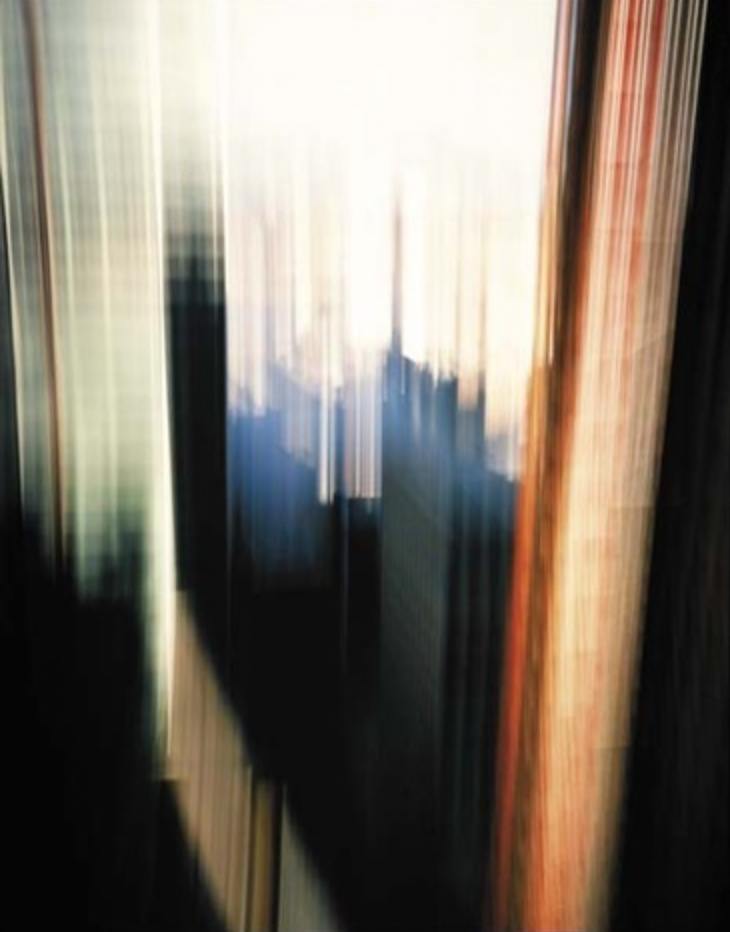 Catherine Yass, Descent: HQ2: ?s, 20°, 0mm, 4mph, south, 2003
Catherine Yass, Descent: HQ2: ?s, 20°, 0mm, 4mph, south, 2003Catherine Yass's 2002 series “Descend” explored a similar theme. Under the political haze of the 9/11 attacks, images she shot using distortions, reversals, long exposures and physical scratches inevitably had a tragic color: can we see a newly built skyscraper without imagining it falling into ruins? Likewise, when we see an electronic image online in the post-photographic era, can we view it as an independent object without purpose or indication (or did we ever have one)?
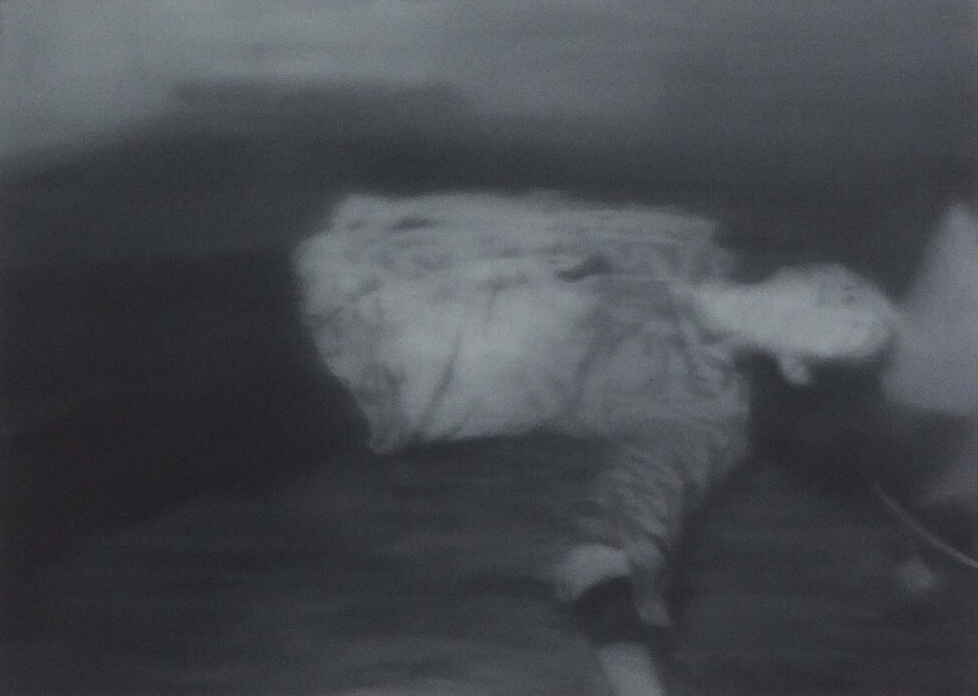
Gerhard Richter, Erschossener 1, 1988
On closer observation, many of Wu's works still retain visible traces of hand-painting, reminiscent of Jeff Walls' "Stumbling Block" and Gerhard Ritcher's "Erschossene". The former is a "digital montage" that combines several edited and directed "documentary photographs" via computer, while the latter is an oil painting in which the painter drew a newspaper photograph by hand. The mediums of these two works are completely different, yet they both manifest a rigorous resistance to images being seen as indexical symbols.
For Wu, this kind of “resistance” is also at the core of her creation. What she aims to show in her photographs is not any object but the photography as an object and the viewers who attempt to gaze at and interpret it. It seems that only when something breaks down and goes wrong does the real mechanism of its inner workings come to light. Jean Boudrillard considers photography to be a "perfect crime" precisely because it is merely a representation of what we want to see -- an empty symbol without context. If we seek to unravel this layer of meaning, we might only find that the nothingness it points to cannot stand up to scrutiny.
Sigmund Freud's theory has a unique understanding of "mistakes". He believed that the interpretation of dreams or subconscious is always fragmented. In these levels, psychoanalysts often interpret details rather than the whole. From the beginning, he viewed the human spiritual realm as a synthetic entity. This point may guide us to understand Wu’s attitude towards images in greater depth. As is shown in the part of images as criminal investigation evidence mentioned at the start of this article, even the most fact-oriented science can hardly avoid the trap of "entering the implied reality through illusions". In the history of photography, it seems that we are always challenged by various illusions. Whether it's the age of Talbot and Niepce or the era of Jeff Wall and Wolfgang Tillmans, it's breaking through our perceptions in dubious ways. The reality we seek from photography seems to be hidden in the darkroom, in the computer, or in the raw files that cannot be seen.
Wu has been acutely sensitive to the concept of “negative films” since the 2015 series “Dissolved Images”. For those who have studied film photography, touching a negative for the first time in the darkroom is indeed shocking. The experience almost has a religious ring to it, as a negative is often perceived as the pending form of a photograph that has not yet taken shape, rather than the photograph itself. This is probably a bit like seeing the embryo's heart beating through ultrasound. In his book Negative/Positive, Geoffrey Batchen delves into the subtle differences in status and the symbiosis between negative and positive films in the history of photography. He quoted Larry Schaff as saying, “From a physical-chemical point of view, there is no essential difference between a negative and a positive in Talbot’s work; the latter is merely a negative of a negative." In fact, not only for Talbot's work, but for all photographs, the positive and negative distinction is politically biased to some extent.
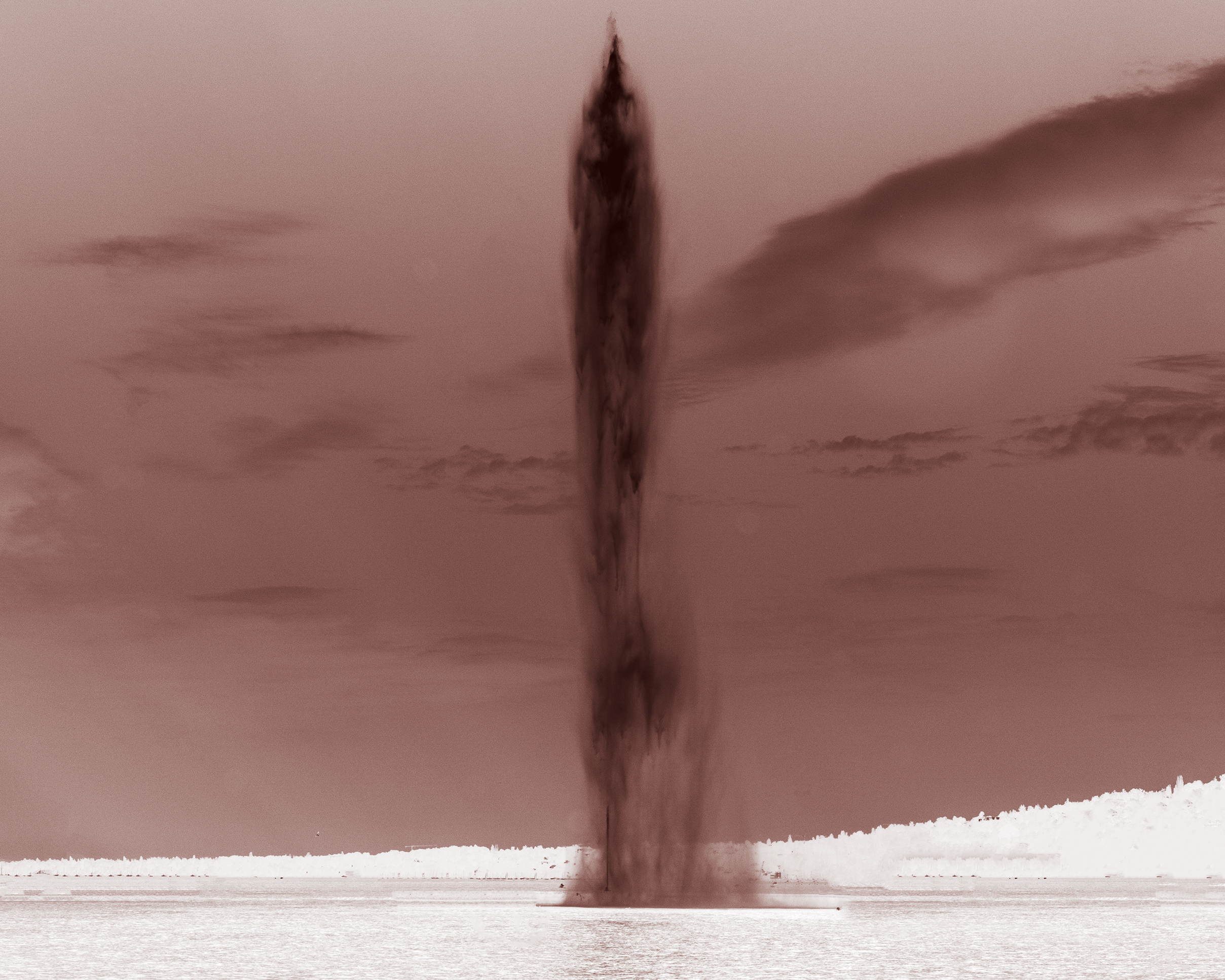
Yumo Wu, The Tanning Traces, from the series The Rupture of Vision, 2021
When seeing a negative, human eyes will repeatedly try to reverse it. For example, you can clearly feel this instinct with the first photo of Wu Yumo's "The Rupture of Vision" series. At first glance, we see a black powdery substance that rises up like a rocket with a breakthrough pattern, and it takes a brain filter to realize that it is a fountain of water rather than dust brought up by an explosion. But what makes this photograph astonishing is that, unlike other negatives, it is a negative that at first glance looks like a positive, as the boundary between the two is withdrawn in the brief processing of the brain.
In fact, if Freud were asked to interpret the relationship between positive and negative films, he would tend to think that the images presented by negative films are "real", while the infinite positive copies are the threat. Slavoj Žižek said that humans are the only animals that can deceive through truth, because there are times when we expect the truth to be taken as a lie so that we don't have to respond to its gaze. When we have to use reversal to confront and identify an image, we should be wary of this: what is the motive for this interpretation? I think this is the essential meaning of what negative films, and indeed any image that is considered "wrong", brings to us.
Is the so-called ethical threat posed by digital art truly as disruptive as imagined over the past half century? We are on the horns of a dilemma—this is the post-photographic era, but it seems that the plight of photography has never been completely overcome. Perhaps it is time to retreat one step in a different direction, and then another, to stand in the most primitive mistakes of the past to analyze and transcend the dizziness it brings to us at this moment.